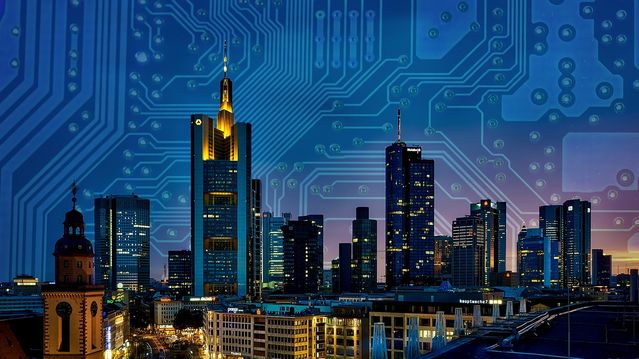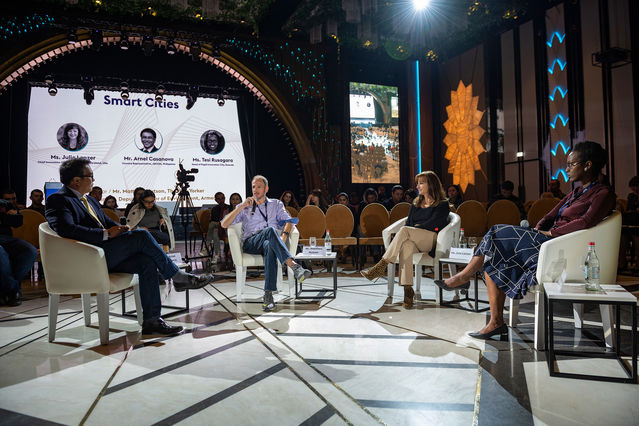Creativity
The Future of Cities
How entrepreneurship, self-driving cars, and surveillance will change city life.
Posted December 27, 2019 Reviewed by Lybi Ma

According to the UN, more than half the world’s population lives in cities, and by 2050 that number will exceed two-thirds. Cities will increasingly define our futures, so what’s the future of cities?
Artificial intelligence will certainly play a role. Last month I attended the Smart City Expo World Congress, in Barcelona, where David Gregory, a manager at Milestone Systems, a video management software company, listed what he saw as the greatest opportunities for AI (particularly machine vision) in city management: traffic monitoring, public safety, incident response, operational efficiency, and crime and terrorism prevention. In one example, he showed how automated video analysis of foot traffic had identified a drug den.
And in October, I traveled to Yerevan, Armenia, for the Global Innovation Forum, where I moderated a discussion with three experts on urban modernization. (GIF paid for my travel.) Julie Lenzer is the Chief Innovation Officer at the University of Maryland; Arnel Casanova is the Country Representative in the Philippines for the civil engineering firm AECOM; Tesi Rusagara is Head of Kigali Innovation City, in Rwanda. They spoke about entrepreneurship, self-driving cars, and surveillance. Below is a condensed transcript.
Matt: Could you each start by briefly describing how you’re thinking about the future of cities?
Julie: I’m a recovering entrepreneur. At the University of Maryland, my charge is unleashing innovation. That includes a center for smart cities. Part of my perspective now is, how do we take really interesting early technologies and get them out into the market?
Tesi: At Kigali Innovation City, our role is to nurture and accelerate the innovation ecosystem in Rwanda. That mandate includes a technology park that’s dedicated to collaboration across academia, the private sector, startups, and government.
Arnel: Prior to joining AECOM, I used to work for the President of the Philippines, and my company built two cities: a 600-hectare business district and a 95-square-kilometer smart city development north of Manila. I also built infrastructure—tollways, seaports, and airports.
Matt: Arnel, a lot of cities are defined by slums and gated communities, sometimes next to each other. How can we increase connection between citizens?
Arnel: Most of the conflicts in the world are created by human alienation where inequality has widened. Central to planning a city is creating a community that can create wealth together.
Matt: Tesi, creating a new campus from scratch, what kinds of insights have you gained about how cities work?
Tesi: If we want people to collaborate, you need to design the campus in a way that allows that to happen.
Matt: Julie, in changing how cities operate, one of the biggest hurdles isn't limitations in technology, but bureaucracy. What’s the solution?
Julie: What it takes is an entrepreneurial approach. Entrepreneurs, we figure out a way we get around barriers. It requires getting really creative about coming to a win-win for everybody, and helping people see what’s in it for them.
Matt: A big part of smart cities is sensing—measuring utilities, behavior, movement. What are the most important measurements we need to increase the efficiency of cities and opportunity for their citizens?
Arnel: What immediately comes to mind is mobility. Because what comes with mobility is economic power, the way you're able to convey services and goods and create relationships among people. And create a vibrancy that ripples outward through the entire country.
Julie: Reliability. When Twitter went down, people were upset because, oh my goodness, we can’t tweet. Well, that’s not a big deal. What happens when the electricity goes out or the cars stop running?
Tesi: Quality of life and productivity. In Rwanda, they’ve put public services online. The amount of time someone needs to spend to get their driver’s license or buy community health insurance, if you have to stand in line, there’s lost wages and lost time.
Matt: Part of sensing is surveillance. People are upset about cameras and facial recognition. Are we going to have to get over our loss of privacy, or do we need regulations?
Julie: I’m not ready to say that my life is an open book and anyone can go make money off my data. We have to look at responsible use of data. There have to be ways to monitor that.
Tesi: I also think we need to give individuals agency over their own data. Sometimes I give my data freely because there’s a convenience factor, but I like that I’m making the decision. That being said, there are safety issues and sometimes we might have to compromise on privacy for the greater good. I don’t think anyone has figured that out yet.
Arnel: In my country, we’ve seen the social media in fake news and false information shape elections—
Matt: I know that feeling.
Arnel: And there was a speech at the dinner last night that mentioned Cambridge Analytica. There's an advantage in having the data, particularly for governments. Technology is ethically neutral, just like money, and the ethics of it depends on the one who wields it. Therefore, there must be someone who is capable of limiting the power of that individual or organization.
Matt: How will autonomous vehicles change cities?
Arnel: I’m more biased towards mass transport and walking. In the city that we started building near Manila, we created a hierarchy of mobility. The first priority would be for pedestrians. When we designed the sidewalks, it'd be very wide with shade and trees. The second priority would be for bikers. The third priority would be mass transport. And the last priority would be cars because cars occupy a lot of space and have a large carbon footprint. Mass transit also creates a community because you get to meet your neighbor.
Tesi: In Rwanda, there’s a big push for mass transport, but how do we move from petrol to electric? There’s ongoing experimentation with motorbikes. VW actually today announced they’re launching their e-Golf in Rwanda. We’re also going to be looking at electric buses. Before we get to autonomous, let’s first make sure we’re using clean transportation and mass transportation. For autonomous vehicles, maybe you'd start with goods before you start with mass transportation and consumers.
Julie: I'd add the cultural change required for people to accept autonomous vehicles. But I think there are other opportunities. In Baltimore, we had a kidney taken from an accident and flown via drone to a hospital for a transplant. So I think, as Tesi mentioned, that we’ll start to see more goods being delivered autonomously before we get to people.
Tesi: We’ve been using drones for blood delivery for three years now in Rwanda. It’s a US company called Zipline.
Matt: To go in the other direction, away from the future of autonomous vehicles: Arnel, you mentioned the old school technology of walking. How can we make cities more walkable?
Arnel: Widen the sidewalks, and make them much more exciting such that there are a lot of stores. Local stores encourage local enterprises to grow and be patronized by the population and also attract tourists. I won’t be going to Yerevan to look for a product that’s internationally available. I’ll be looking to taste the food, listen to the music, and that's provided by the local entrepreneurs. So in my country, in the capital, we've lost much of that, because the malls have taken over, and we've lost the identity of the city. It's really important that a city would have its soul and its identity. That also leads to positivity and creativity.
Julie: Coming from Baltimore, security has to be a factor for people to be willing to walk.
Matt: In the last couple of minutes, do any of you have any favorite experiments that you’ve seen other cities try?
Julie: I think the jury’s still out on electronic scooters. If you’ve walked through cities when electric scooters were released, you'd trip over them. And safety issues have come up.
Tesi: Maybe two things. One would be urban agriculture. And the second would be more public spaces. How do you integrate your culture, the history, so that it’s still very unique and you maintain the identity of the city? And how do you incorporate the arts community and the design folks?
Arnel: Smart infrastructure, smart utilities. For example, smart grids allocate the power load from one location of the city to the next. Also urban agriculture. You have now technologies like hydroponics, vertical agriculture, one building will be like a farm. And smart transportation, for commuters to immediately identify which one is the best transport to take, so wayfinding for moving around.
Matt: Speaking of moving around, we just received a stop sign. So I'd like to thank you all for being here.





